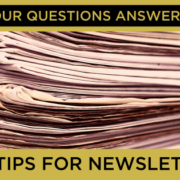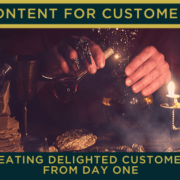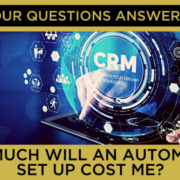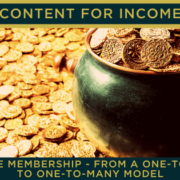Content that supports sales
When it comes to your lead to sale process, great content plays a vital role.
To create a content-rich customer journey, one of the tried and tested best-practice models I recommend is the A.I.D.A principle, which first emerged back in the late 1800s.
The A.I.D.A acronym stands for:
- Awareness
- Interest
- Desire
- Action
For businesses with marketing and sales teams, your marketeers get things underway by creating content that brings awareness to your brand. This engages potential customers through emotional triggers that spark their interest. They’re then passed to your sales team as a person who’s interested in your product/service. Your sales team can then create the desire and action for a purchase to be made.
Ultimately the best content is the type that everyone aligns and subscribes to. It ideally under-promises and everybody over delivers along each step of the client journey.
Planning your sales content
When you’re planning your content using A.I.D.A, the key things you need to do are:
- Start with the end in mind. Who are you specifically trying to appeal to? And please don’t just say anyone, because “anyone” doesn’t work with the reticular activating system in your brain – you need specifics!
- So, who is the ideal person that needs to read your content? What are they interested in? What value do you want them to get? What do you want them to learn or do with it? And finally, what’s their call to action?
- Play with emotions. I believe when your content appeals to humour, pleasure, fear, or intrigue, it enables your sales team to pick up the baton and move the person from interested party to paying client.
It’s important to involve everyone along the chain to ensure the awareness piece is something that the sales team sell, and the operations team can deliver. So, good communication is needed in the planning as well. A helpful thing to do in this process is to ask your client about their experience, and why they bought from you because success leaves clues!
As well as celebrating their wins, your sales team also needs to be inquisitive and ask new customers probing questions: why they decided to go with your business and what specifically made them pick up the phone/ask for more information/come to the demonstration/etc?
Ultimately, it’s about creating a feedback loop – the more you ask what you’re doing right, the more you can do that thing and therefore the more interest you generate and potential customers you create.
This can also be applied when a potential lead is a no. Don’t just be dismissive of it – there’s a lot of information to be gleaned. It’s important to understand what didn’t work. So politely ask where you went wrong in the process and why they didn’t become your client? Often what you hear is that your content says you can do X but when they talked to sales, they couldn’t deliver that at all, so their time’s been wasted. Information like this gives you a clear understanding of where the link in your message got broken, so it can be fixed in future.
Where content for sales goes wrong
You must have 100% belief and certainty in the ability of your products or services to deliver on your promise. If you ever feel that isn’t true, then it will come across to your customer as lacking authenticity. This leads to a lack of trust, which can be disastrous because trust in the know, like and trust journey is crucial.
Another key thing is to be very clear in your content and focus on giving value first and conversion to sale second. Content that’s too salesy and makes your potential customer feel duped or pressured to commit before they’ve made an emotion-based decision, doesn’t work.
Giving value in your content
When the main purpose of your content is to give value, sometimes the concern is that you’ll give so much away (particularly with a service business) that people will feel they don’t need to buy from you.
The solution to this is to give people an overview of your map, but only go into detail about a small portion of the journey. For example, I might do a webinar about referrals and cross selling. During that webinar I’ll give some of the steps, while seeding interest about the final part of my methodology. Then at the end I’ll let people know that if they want the full process, they’ll have to buy that from me.
Where content works well in a sales process
It’s important to remember that we all learn and digest information in a variety of ways – some of us are auditory, some visual, and so on – so don’t rely solely on one style of content for engaging your customers.
The best content mixes things up with eBooks, podcasts, whitepapers, webinars, videos, cheat-sheets, etc. This mixture of content engages a wider audience and shows that you’re a voice of authority and a place of trust and value. When customers are ready, they’ll knock on your door and ask for further engagement.
But it’s no good just doing your eBook for example and then sitting back and waiting for people to come and buy from you – you must act! I look at content like a shop window. First, you attract people with beautifully curated and enticing goodies (value) so they’re intrigued to cross the street and look in your window. Once you’ve piqued their curiosity and they want to come in and browse, welcome them and show them what you have to offer in a non-pressurised and interesting way. Then let them make a choice as to whether they purchase or not.
It’s also helpful to use a range of channels for delivering your content. Go where your customers are. If most of them lurk on LinkedIn, then you need to be there too. If they like face-to-face networking, then get networking.
The key thing to remember is this. Once you start bringing customers in with your content, ensure your shop window is ready for scrutiny! Wherever people can find you (be that website, social channels, or elsewhere), everything must be up to date and marrying up with the message your content is putting out. There’s nothing worse than saying you’re fantastic and then someone goes and looks on your blog and the last entry is 6-months old, or your social channels haven’t been posted on in months!
Keep things up to date and aligned and watch your sales start to soar!
Many thanks to Chris Wilson for this Guest blog. Chris is a sales coach and the owner of Adamo Business Consultants. You can connect with Chris directly via his LinkedIn page.












Leave a Reply
Want to join the discussion?Feel free to contribute!